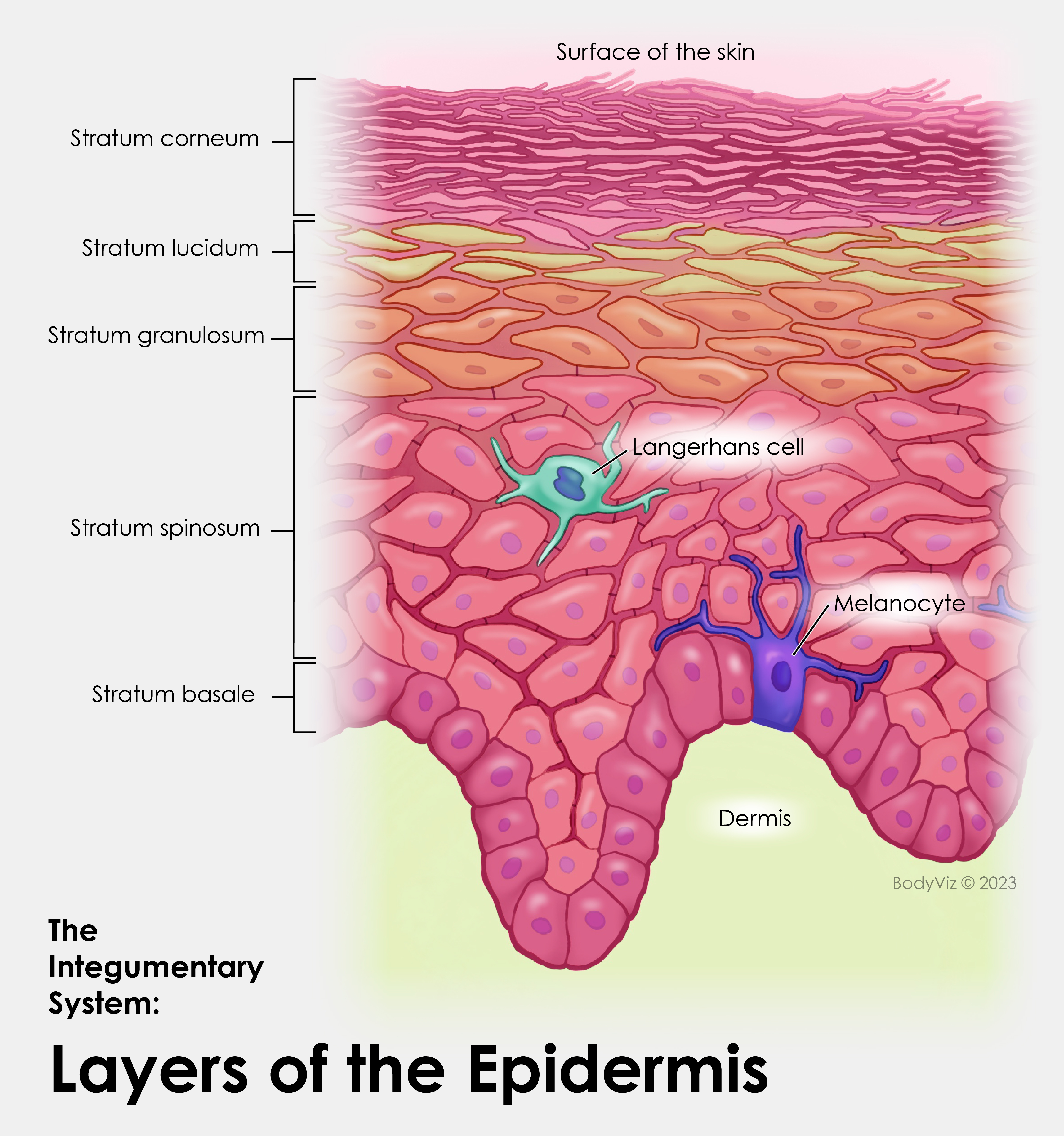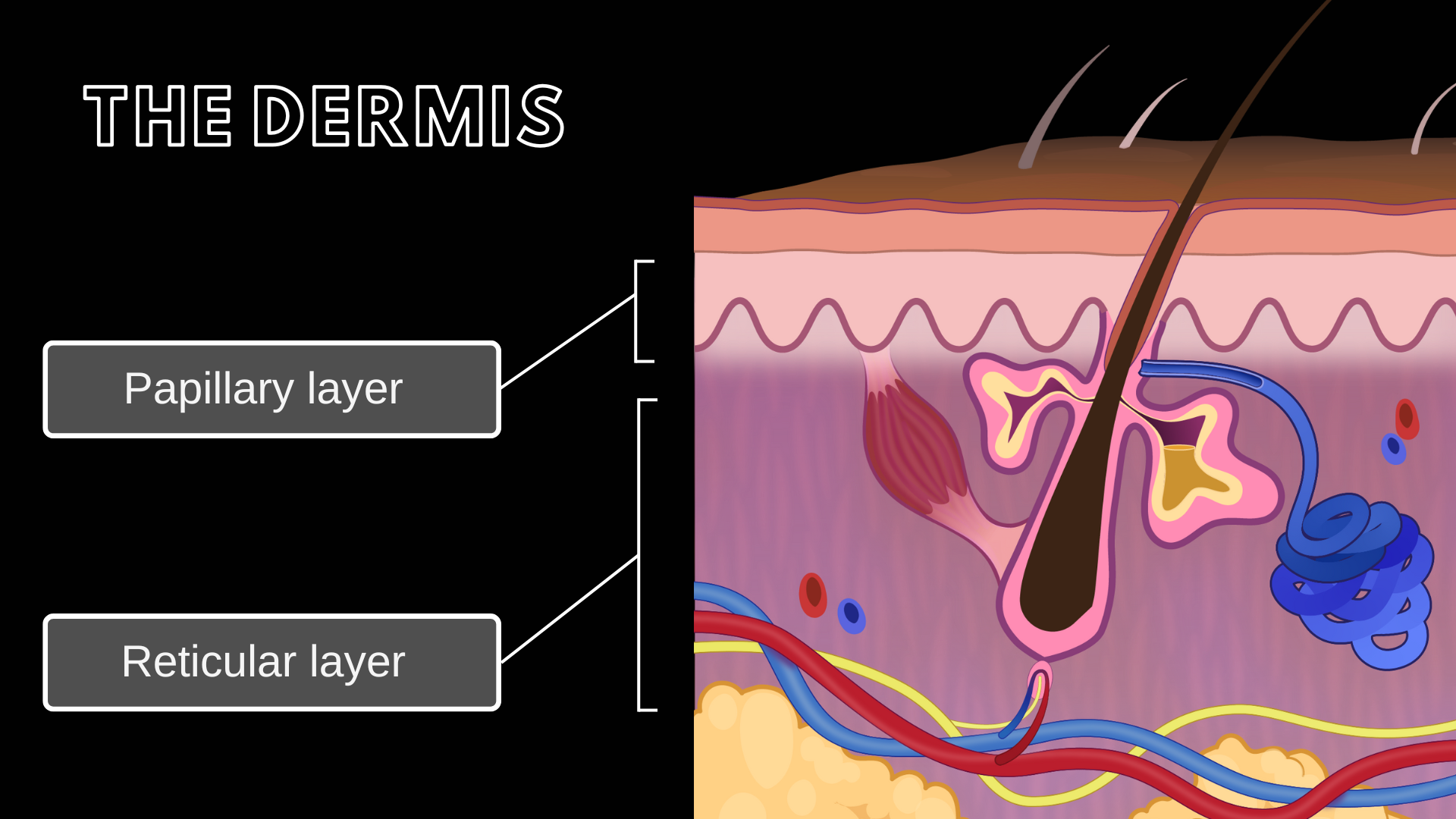The Integument and Eczema
by Robert Tallitsch, PhD | April 22, 2024

Video explaining The Integument and Eczema with a patient example case study!
Use the button below to schedule a demo to learn about our activities, flash cards, and other anatomy resources that support this Brain Builder!
Schedule a Demo
Eczema is an inflammatory skin condition that affects more than 31 million adult Americans, according to the latest CDC figures. In addition to these adults, between ten and twenty percent of infants will develop eczema in their first few months of life. However, more than half of these infants will outgrow the condition or will have significant improvements as they grow older.
In this Brain Builder we will discuss the layers of the skin and the accessory structures of the skin that are responsible for protecting the skin. Then we will discuss what eczema is and its different forms. Finally, we will discuss eczema’s symptoms, causes, and treatments.
Functions of the Skin
For a detailed explanation of the anatomy of the different layers of the skin go to The Integumentary System and Burns.
The integumentary system, or integument, is composed of the skin and its derivatives (nails, hair, and glands). The functions of the integument include
- Protection from environmental microorganisms
- Protection from desiccation (drying out)
- Synthesis and storage of lipids
- Excretion of wastes
- Regulation of body temperature
- Synthesis of vitamin D3
- Coordination of immune responses involving cancers and other pathogens of the skin
- Sensing environmental stimuli
Epidermis of the Skin
As was discussed in the Brain Builder referenced above, the skin is composed of the superficial epidermis, and the deeper dermis. The epidermis of thick skin, which is found on the palms of the hands and soles of the feet, is composed of five layers. The epidermis of thin skin, which is found on the remaining surfaces of the body, is composed of only four layers. The epidermis is the protective layer of the skin.
The layers of the epidermis are, from deep to superficial, the stratum basale, stratum spinosum, stratum granulosum, stratum lucidum (which is found only in thick skin), and the stratum corneum.

Superficial to the stratum spinosum is the stratum granulosum. Cells within this layer have moved superficially out of the stratum spinosum. Stratum granulosum cells release granules by exocytosis. These granules contain keratin and keratohyalin, lipid-rich substances that will, in more superficial layers, completely coat all of the cells within the stratum corneum and protect the skin from environmental microorganisms as well as contribute to the cells’ water resistance.
The stratum lucidum, which is superficial to the stratum spinosum, is found only within thick skin. Cells within this layer lack organelles and a functioning nucleus, and are densely packed together. The keratin proteins are fully formed and bind the cells of this layer tightly together.
The most superficial layer is the stratum corneum. This layer is composed of dead cells that possess a very thick cellular membrane, lack any organelles or nuclei, and possess a high amount of keratin. The intercellular connections formed within the stratum spinosum are still fully intact and bind the cells tightly together. In addition, the lipid-rich substance formed by the cells of the stratum granulosum completely surrounds the cells of this layer. These characteristics contribute to the protective nature of the stratum corneum against environmental pathogens and contribute to the cells’ water resistance.
The Dermis of the Skin
Deep to the epidermis is the dermis, which is composed of two layers: a reticular layer and a papillary layer.

The reticular layer is the deepest layer of the dermis. This layer is composed of densely interwoven connective tissue fibers that surround blood vessels, nerves, hair follicles, sweat glands, and sebaceous glands. The connective tissue fibers of this layer extend deeper into the subcutaneous tissue, and superficially into the papillary layer. As a result, all of these layers are held tightly together.
The papillary layer of the dermis, which serves to mechanically anchor the epidermis to the dermis, is composed of loose connective tissue. The papillary layer contains a large number of capillaries and neuronal axons. The capillaries nourish the epidermis and remove epidermal wastes by diffusion. The neurons provide sensory input coming from epidermal sensory receptors.
Sebaceous Glands of the Skin
As mentioned previously, the keratin of the epidermis is a protective protein that completely coats the epithelial cells of the stratum corneum, the most superficial layer of the epidermis. This coating contributes to the protective nature of the stratum corneum against environmental pathogens and contributes to the cells’ water resistance. However, because of the keratin, the cells of this layer, once exposed to the environment, become dry and brittle.
Sebaceous, or oil glands, produce a thick, waxy, oily lipid termed sebum. The sebaceous glands release sebum into the hair follicles of the skin. Sebum travels superficially in the hair follicle and is released onto the surface of the skin surrounding the hair, lubricating, and protecting the keratin of the hair and the surrounding epithelium.
Sebaceous follicles are large sebaceous glands that communicate directly with the epidermis. These follicles never produce hair and are found in the skin of the face, back, chest, external genitalia, and nipples of the breast. These glands also produce sebum that lubricates and protects the keratin of the skin on these portions of the body.
Eczema
Eczema, also known as dermatitis, is a non-contagious inflammatory skin condition. As a result of this local inflammation the skin dries, becomes itchy, and often develops rashes, scaley patches, blisters, and skin infections.
Although the symptoms of eczema can occur anywhere on your skin, they appear most commonly on one or more of the following locations:
Eczema symptoms may appear once, and then disappear and never recur. Other individuals will experience periods of intense symptoms, termed flares, followed by an indefinite period of no symptoms anywhere on their body.
Although the most common form of eczema is atopic dermatitis, six other forms of eczema exist. Many of the symptoms overlap between types, and a definitive diagnosis of a specific form of eczema is often difficult. The forms of dermatitis include
The symptoms of eczema can be different for everyone. Eczema is often mischaracterized as psoriasis, even though these two conditions are quite different. The symptoms of eczema always include dry, itchy skin. However, eczema may also cause additional symptoms, such as food allergies, hay fever, and/or allergic asthma.
Causes of Eczema
Eczema results from a genetically-driven, enhanced response of the immune system that causes the skin to become overly dry and, as a result, itchy. Research indicates that an individual prone to eczema is lacking in a protein termed filaggrin. One of the functions of this protein is the maintenance of moisture within the skin.
One of the most common factors causing eczema is an enhanced interaction between an environmental stimulus and one’s immune system. When the skin comes in contact with a particular environmental stimulus, the individual’s immune system becomes overly active, producing an eczema flare, resulting in inflammation of the skin.
Numerous environmental factors have been demonstrated to trigger an eczema flare in individuals. Such environmental factors may include, but are not limited to
-
Dust mites
-
Extended exposure to dry air, extreme heat or cold
-
Various types of soap or shampoo
-
Chemical additives in laundry soap or detergents
-
Certain fabrics in clothing, bed sheets
-
Formaldehyde, which is a common additive in many household disinfectants, glues, and adhesives
-
Antibacterials found in baby wipes and other personal care products
Diagnosis and Treatment of Eczema
Eczema is typically diagnosed following a complete patient history and a detailed examination by a dermatologist.
Treatment of eczema is as varied as its causes. Treatments may include, but are not limited to:
-
Determining what environmental factor causes an eczema flare in a patient and then striving to eliminate that factor from a patient’s daily life
-
Use of over-the-counter or prescription skin moisturizes throughout the day during a flare.
-
Medications, such as anti-inflammatory medications or immunosuppressant drugs to lessen the immune system’s response to environmental factors that cause eczema flares
Although eczema is rarely harmful to the rest of one’s body, it is irritating and can be embarrassing. Most children outgrow the condition or experience significant improvement in their condition as they grow. Eczema is a chronic condition, and there is no cure for eczema. Sadly, no treatment can eliminate one’s symptoms completely and every time.
Key Terms
Dermatitis - Inflammation of the skin. Another term used to describe eczema.
Dermis - Skin is composed of two layers — the epidermis and dermis. The dermis is the deeper of the two layers.
Stratum lucidum - A layer of thick skin that is absent in thin skin.
Keratin - A chemical compound synthesized in the cells of the epidermis of the skin. This chemical protects the skin from microorganisms and contributes to the water-resistant characteristic of the skin.
Thick skin - Skin that is found on the palms of the hands and soles of the feet. Thick skin has five layers to its epidermis.
Stratum corneum - The most superficial layer of the epidermis of the skin. This layer is composed of dead cells.
Formaldehyde - One of the chemicals that is known to cause eczema flairs. Formaldehyde is a common additive in many household disinfectants, glues, and adhesives.
Immunosuppressant drugs - A class of drugs that reduce the activities of the immune system. This class of drugs is one of the treatments available to patients of eczema.
Schedule a demo today to learn how you can incorporate BodyViz into your classes!
Schedule a Demo
Helpful Links